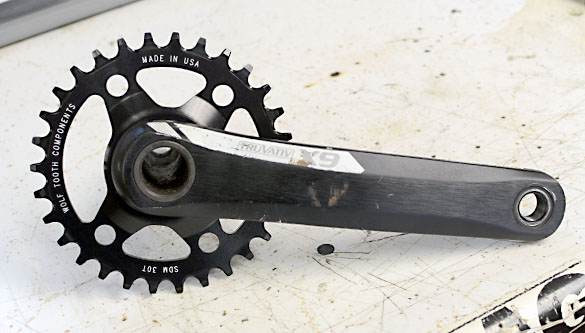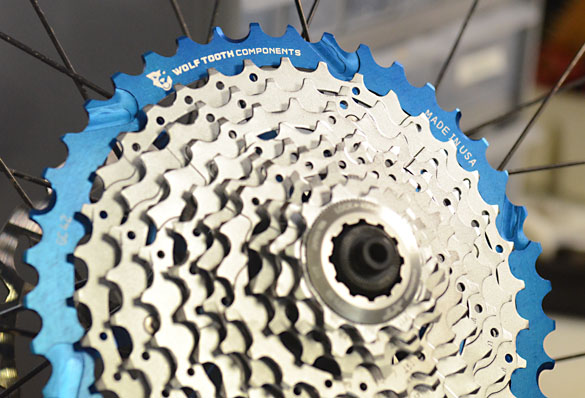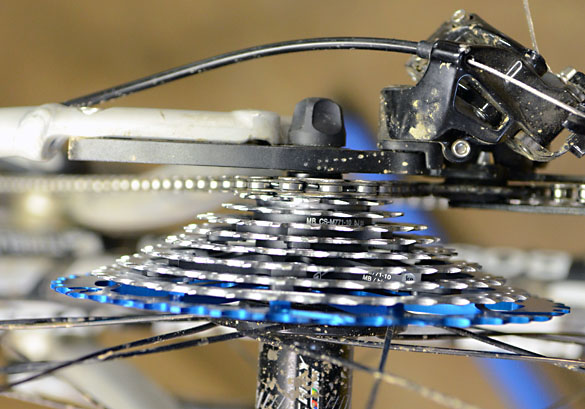Installation: Wolf Tooth Components 1×10 setup
Originally posted on May 14, 2014 at 10:40 am
Single chainring drivetrains have taken the mountain bike world by storm over the past few years. For many riders in many types of terrain, it just works. There are fewer gizmos on the handlebar, fewer moving pieces to maintain, and thanks to new products like Wolf Tooth Components‘, nearly all of the range of gearing—nearly that of a double chainring setup. They also work wonderfully to clear the rear tire on fat bikes and are necessary on some new suspension bikes that don’t even bother with a front derailleur mount.
I’ve been running my hardtail as a 1×10 for a few months now and have been quite happy with it, but there were certainly times I could have used an extra cog at the low end, and really never felt like I was spinning out on the top end. I wanted to gear down but normally a typical 32 chainring and 36 cog is as low as you can go. Now, Wolf Tooth is one of a handful of brands now producing 40 and 42 tooth adaptor cogs and SRAM-compatible direct mount chainrings with the narrow/wide pattern. They were kind enough to send over a set and I installed them this week.

First up is the chainring. SRAM is one of a few brands that offers cranksets with a spiderless design, meaning the chainings attach directly to the arms. However, oddly enough, SRAM doesn’t build or sell its own direct-mount chainrings, even for the 1×11 groups. But the aftermarket is glad to fill in, making switching chainrings a breeze and allows you to run chainrings smaller than what will fit on a normal four-bolt spider. In fact, Wolf Tooth offers its chainrings in sizes from 36 all the way down to 26 teeth. Since I wanted to go a touch lower than the 32t I had before, I chose a 30t for this build.

The $78 direct mount chainrings are available in two offsets for BB30 cranks, standard GXP cranks, and Middleburn cranks. All are proudly made in Minnesota from 7075 aluminum with a narrow/wide tooth profile they call Drop-Stop to eliminate the need for a chain guide. It can be used with 9, 10 or 11 speed systems.

Next up is the cog, or GC Cog, as it’s called—though I’m guessing the “GC” stands for “Giant Cog”, which would make it the “Giant Cog Cog”, but anyway….
Designed to fit behind a cassette, it gives you that extra gear you always wish you had on the steepest of climbs. To make room, you jettison the 15 or 17 tooth cog and its spacer. Why not the 11t you ask? I asked them, and they pointed out that the whole point of the GC is to extend the overall range of the cassette, from high to low. If you toss out the high gear, you are effectively lowering the overall range without spreading it. This could more easily be done (and more affordably) with a smaller chainring. Wolf Tooth does the math on its website, and they pointed out to me that if you removed the 11t and added the 42t, you would have even less range than you started with.

One drawback to all this is that if you use a Shimano cassette, you need to use a cassette with separate cogs, specifically a Shimano XT or XTR. SRAM cassettes are usually compatible. I had to purchase a new XT cassette to make the setup work. There are also different cogs for Shimano and SRAM, with different machining to make sure the shift ramps line up correctly. The two are not interchangeable. There is also a 40t version for Shimano 11-34 cassettes. More compatibility questions are answered here.

Installed it looks like just another cog, unless you opt for a blue, red or black anodized finish. With my SRAM Type 2 rear derailleur, it easily cleared the upper jockey wheel, though Wolf Tooth offers an extra-long B-limit screw if you should need it, a likelihood with Shimano derailleurs. Suspension bikes with chain growth are more susceptible to this issue. It’s also a full 4mm wide at the splines, significantly wider than a normal cassette cog, so you shouldn’t worry about it damaging your freehub, even with all that extra torque moving through.

The jump in cogs where the 17t used to be is noticeable, but only if you’re looking for it. I haven’t ridden it yet so we will see if the gap is perceptible. You may also have to adjust your chain length. Since I went to a slightly smaller chainring I was good to go without making a change.
Well that’s it. I’m ready to ride. Stay tuned to an upcoming issue of Dirt Rag for the full review. Subscribe now and never miss an issue.